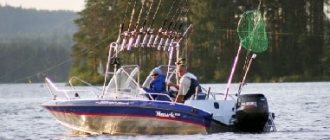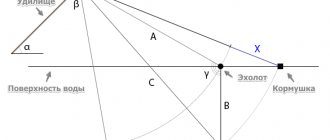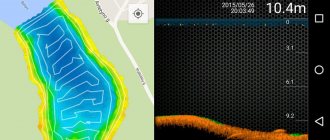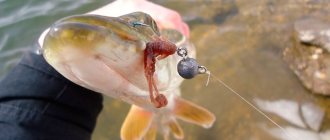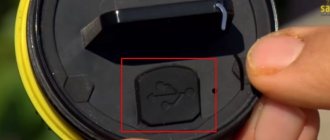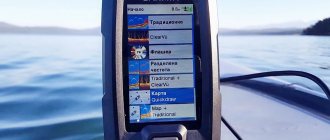How does an echo sounder work?
The echo sounder consists of two main parts - a transducer element and a main processor plus a display. The latter is essentially a small computer that processes the information received from the converter and converts it into digital signals on the screen.
The transducer contains piezoelectric crystals that are used to send the sonar pulses into the water by vibrating at a specific frequency. When these pulses collide with an object, they are reflected back to the sensor, which receives the signals and transmits them to the main unit for interpretation.
Diagram showing how sending and receiving a sonar signal works
Based on the intensity of the signal returned, as well as the time it takes to travel through the water, the echo sounder can calculate the shape and location of objects reflecting the sonar pulse. This process is repeated dozens of times per second, which helps improve resolution and generate a live image of what's happening in the sonar cone.
The details that can be interpreted from sonar signals also depend on the power and frequency of the pulses. Because of this, many fish finders use several different frequencies simultaneously to collect additional information.
Fishermen often ask the question “Can a fish finder be used outside of water?” The short answer is no. The echo sounder only works in water. However, you may be surprised to learn that you can use a fish finder through ice because ice easily transmits sonar signals.
Echo sounders used for ice fishing
For ice fishing, echo sounders are made from frost-resistant materials and are attractive for their portability. Alternatively, you can use fishing devices from a boat. Most winter devices are wireless devices, the sensor of which is located far from the device itself and looks like a regular float.
Tips for fisherman: Spoons for vertical trolling from a boat - Detailed review
In order not to make a mistake in choosing a winter echo sounder, it is recommended to pay attention to the name of the device, which is marked Wireless.
The category of popular winter echo sounders includes: Elite-4x Ice Machine, Elite-4 Ice Machine, Fisherman 220 Duo Ice Edition, Fisherman 600 Ice Edition, all kinds of tube echo sounders for ice fishing.
• support for the NMEA protocol is necessary to control navigation devices and steering using an echo sounder.
2D sonar vs sonar with bottom image
Traditional fish finders rely on 2D sonar (which includes CHIRP sonar), while the latest generation of fish finders rely on downward imaging sonar.
Traditional 2D fish finder transducers are circular in shape, and as a result, they emit a sonar signal that expands into a circular cone as it moves down through the water. Because of this, they collect sonar information from a fairly wide circular area under the boat.
Bottom image sonars, on the other hand, use a thin rectangular transducer that directs a narrow sonar beam directly into the water. The resulting bottom shot shows highly detailed information captured in a narrow cross-section directly below the boat.
Each type of sonar has its own advantages and disadvantages:
- 2D sonar is great for scanning the area below you to find game fish, which appear as arches on the screen. However, very often the outlines of objects on the screen are "fuzzy" and indistinct, making it difficult to identify details. For example, a school of baitfish typically appears as a large blob on a traditional 2D fishfinder, although CHIRP has actually improved performance in this regard.
- Downimaging sonar is great for detecting discrete structures, including fish resting on the bottom (which cannot be detected with 2D sonar) or individual fish within a dense school of bait. The downside to this type of sonar is that it only picks up a very narrow portion of what's directly below the boat, while missing anything that's a little further away.
Fishing with an echo sounder from a boat: nuances
A fish finder always needs a power source. Without it, autonomous operation of the device will be impossible. Special batteries are produced for echo sounders, which are small in size, light in weight and have a completely sealed design. The more powerful the battery, the larger and heavier it is. In the case where it is possible to connect the device to the ship’s onboard system, an additional battery or power source is not needed.
When choosing an echo sounder for fishing, you need to think in advance about how and at what point on the vessel the sensors will be attached. Now on the market you can find a lot of special accessories that allow you to quickly install sensors on almost any vessel and just as quickly dismantle them. An echo sounder for fishing from a PVC boat in this regard is no different from an echo sounder for a metal or wooden boat.
Before you start using the echo sounder, you need to configure it to suit the fishing conditions and your personal impressions. By default, the fish finder for fishing from a boat has factory settings.
Downward visualization versus sideways visualization
As the name suggests, the bottom image is focused straight down in a narrow area, while the side image sends signals directed to the sides (both left and right). This helps gather information about the general area around the boat.
Again, each of these types of sonar has its own advantages and disadvantages:
- The side view is great for viewing a large area surrounding your boat on both sides. You can quickly identify protruding structures such as boulders, sunken trees and weed beds, and determine bottom density. However, it is not very good at recognizing smaller objects such as fish.
- As mentioned, downward imaging is ideal for getting detailed information about what is directly below the boat, but does not provide a general overview of the area.
As you can see, none of these sonar technologies are perfect on their own. Instead, they are best used in combination, which is why many modern fish finders include all three types of sonar.
Once you learn how to use each sonar type individually, you can switch between them to get the maximum amount of information. Check out our detailed guide on how to read a fish finder to improve your skills in this area.
What is CHIRP on a fish finder?
CHIRP sonar technology is relatively new and stands for Compressed High Intensity Radar Pulse. While traditional 2D sonar uses only one frequency, CHIRP sonar uses a range of different frequencies, sending both low- and high-frequency signals.
If you're interested in learning more about CHIRP, check out our article on how to read CHIRP sonar.
Echo sounders with GPS
Many modern fish finder models include GPS functionality, which can really help improve performance. First, it allows you to jump to specific points on the map. But even better, it allows you to place a GPS marker in specific locations that you want to use as landmarks. This could be a reef, for example, or a large underwater structure such as a shipwreck, or areas where there is a change in bottom density that often attracts fish.
Some high-end models use GPS along with a chartplotter. This way, you can create your own map of the waters as you explore them, allowing you to quickly and easily return to better spots in the future.
The two best mapping programs currently available are Navionics and LakeMaster. If you want to know more about them, check out our article on Lakemaster vs Navionics – which is better.
What is the principle of operation of an echo sounder?
To find out how a fishing echo sounder works and what processes underlie it, you need to find out what parts it consists of.
The echo sounder circuit consists of four main blocks: transmitter, transducer, receiver and screen.
The transmitter, immersed in water, emits ultrasonic waves of a certain frequency. Dissipating in the water, the wave encounters obstacles in its path in the form of fish, algae, stones, reefs and the bottom. Pushing off from these surfaces, it returns back to the converter.
The speed of sound propagation under water is constant. Depending on the depth at which objects are located, the waves take a certain time to be reflected. It is thanks to such calculations that it is possible to accurately determine the depth and topography of the bottom, obstacles along the way and the presence of fish. The sound of the echo sounder is practically imperceptible to humans and fish, so you don’t have to worry that the emitted waves will scare away all the living creatures.
Types of converters and how they work
Although many fish finder models are sold with a transducer, they can also be purchased separately, and you can use the fish finder with several different types of transducers.
Different converters operate at different frequencies, which means you need to choose the right frequency for your specific application. For freshwater sport fishing, the frequency range is 50 to 300 kHz, with 200 kHz being the most common.
Additionally, you should know that traditional 2D sonar sensors are different from CHIRP sensors. So, if you want to use CHIRP, make sure you buy a CHIRP-enabled converter that covers the frequencies you want to use, which is 150-200 kHz for most freshwater applications.
If you have a sensor but aren't sure if it's working properly, check out our article on how to tell if your sensor is bad.
Sonar Transducer Installation Type
Different types of converters require different mounting methods. Inside the housing, some transducers should not be in direct contact with water because they may transmit sonar through the housing. They can be glued to the inside of the case. However, they don't work with all case types, so be sure to check before purchasing.
A transom mount is the most common type of transducer mount and relies on an adjustable bracket attached to the outside of the hull, usually at the rear of the boat or kayak. With this mounting, the sensor is immersed in water.
Trolling Motor Mount Some transducers can be attached to the side of the trolling motor or even inserted into the propeller hub, allowing them to be inserted into the water as well.
Conclusion
To sum it up, fish finder technology has come a long way in recent decades. The highest quality models now combine CHIRP sonar, downward vision, side imaging and GPS, and this combination of high-quality technologies allows experienced anglers to quickly and easily find promising fishing spots where they previously spent days or weeks trying to find them.
If you'd like to check out some more high-end models that cover all of today's sonar technology, check out our review of the Lowrance Elite 9 TI, as well as our review of the Garmin Striker 7SV. Finally, if you're into ice fishing, you might be interested in our review of the best flasher for ice fishing.
Inexpensive echo sounders
Today, for 10-20 thousand rubles ($150-300) you can purchase a working echo sounder with a high-quality color display and DualBeam technology, which involves scanning water with two beams.
Tips for fisherman: What pressure should be in a PVC boat - What to choose for fishing
Competition among manufacturers in this price category is very high, and therefore the range of such echo sounders for PVC boats is quite large.
A good price-quality ratio is typical for devices from such well-known companies as Humminbird, Lowrance, Garmin and Phiradar, and therefore we will talk about individual devices from these manufacturers further.
LUCKY FF1108-1
- a reliable and simple device with fairly wide functionality.
- high accuracy of depth measurement - up to 100 m.
- acceptable cost - at the level of 4,000 rubles.
- b/w screen scanning depth up to 100 m 1 beam.
- portable design.
- transducer in the form of a float.
- powered by batteries/accumulators
Lowrance Mark-5x PRO
This black-and-white, low-cost, dual-frequency model from Lawrence features a high-resolution five-inch display with a modern design and improved auto mode. The operating temperature ranges from -15 to 55 degrees. Thanks to the backlight of the screen, the sonar can work effectively both during the day and at night.
The maximum scanning limit at the prospective location is 305 m, and the total radiation angle is 120 degrees. Mark also attracts the attention of anglers with the presence of a useful TrackBack function, which allows you to view the history of received data. Second place in our ranking.
Practitioner ER-6PRO
Portable domestic echo sounder. Operates in a temperature range from -20° to 40°C. This spread allows it to be used both in hot weather and in cold winter. The echo sounder is powered by one AA battery. Small in size and with only one beam, with a scanning depth of 25m .
This specimen initially leaves a very negative opinion about itself. However, in the process of using it, it gradually gains trust. The low price, as well as the presence of 5 different operating modes, make the device simply indispensable for fishing.
Disadvantages also include stiff buttons , which are sometimes difficult to press in winter.
The sensor MUST have full visibility from side to side. There should be no obstacles in the signal path: no motor, no transom plates, no convex parts of the hull, no fastening elements of other sensors. The location where the sensor is mounted on the boat may vary.

